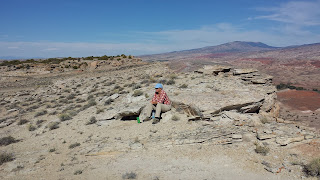 |
| Not everyone is in a hurry to go South |
 |
| Unexpected Dangers! |
Descending the East flank of the Rockies everything changed. The plains of Alberta are covered with gas wells, wheat fields and cows. Northern Montana was much the same, perhaps with a few less wells, and wheat but still rolling hills, far flung towns and cows.
It took us 6 days to drive the 2100 miles that marked the half-way point. We now had 6 weeks to drive the remaining 2100 miles, and we plan to take it slow and do some exploring.
 |
| Just hanging out in Wyoming |
Southern Montana, along the Yellowstone River that the land began to change. Big mountain ranges rose off to the west and south. As we climbed up out of the valley, the land was still agricultural but the crop changed to something short with big, leaves. All we could think of was some type of mutant spinach, until we drove through Lovell, Wyoming and the sugar beet processing plant. Ah, Dave said "Sugar beets!"
We were in Lovell, not your usual tourist destination because Dave, who somehow has an uncanny knack for looking at a map picking good camping spots had noticed a big green blob labeled "Bighorn Canyon National Recreation Site". Lovell being the location of the site headquarters we were there to see about camping and hiking options.
Currently I'm typing all this up while seated outside the Creekside at Horseshoe Bend Campground. Below and to the South the waters of the southern end of Bighorn Canyon sparkle under a vast, baby blue sky. A mile to the west a solid red and white rock wall rises 2, maybe three thousand feet. Bees are buzzing around the late blooming purple asters and sunflowers. We are back in the high desert.
 |
| The Lockhart Ranch. If I were interested in ranching.... |
The majority of the canyon lies to the North. Yesterday we scouted out some hiking trails to take later today. Some wander along the canyon rim. (Bighorn Canyon is the third largest canyon in the US), and others wind up side canyons to old cow and dude ranches. It's been a great place to explore for a few days. The worst part of stumbling into places like this is knowing that eventually you have to leave.







